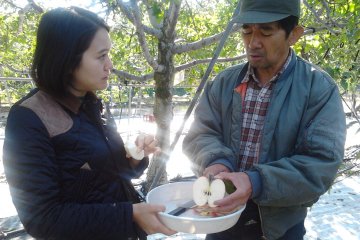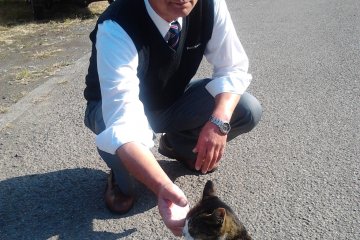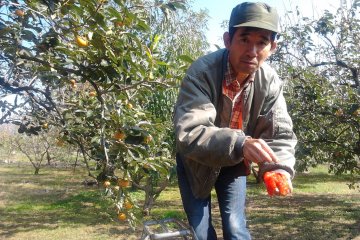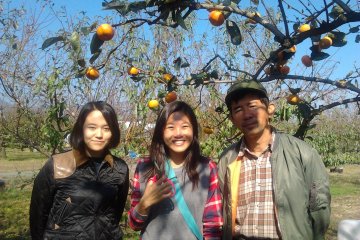The prefecture of Yamanashi is nicknamed “King of fruits,” and not without good reason. Being blessed with space and the mountainous climate of extreme temperatures, Yamanashi’s fruits are incredibly tasty, and they grow in abundance.
One morning, I got up early to go to Nakagomi Orchard, named after its owner Nakagomi-san. It was a 40-minute bus ride from my hotel, RISONARE Yatsugatake.
Nakagomi-san has stayed in the US for 8 years and is currently teaching English in Tokyo. He speaks fluent English and is passionate about showing and teaching the techniques of planting delicious-tasting fruits. Even though he has a job in Tokyo, he still returns, every weekend, to Yamanashi to take care of his orchards.
Upon arriving, Nakagomi-san gave us carrier bags and a plate with a knife. We were then told that we have 30 minutes in the apple orchard and 30 minutes in the persimmon orchard and encouraged to eat as much as possible.
Before we went ahead to pick the fruits, Nakagomi-san apologized that the orchard was terribly affected by the recent Typhoon no. 26, which caused many fruits to be bruised from the movement of the branches in strong gusts of wind. His wife also explained to us the best way to pick the fruits and the way to choose the sweetest fruits. For apples, those with a rough surface are better. “It’s the same with boys! Don't pick the handsome ones,” joked Nakagomi-san. For persimmons, those with a greenish tint are the best.
In the apple orchard, Nakagomi-san cut apples from different varieties for us to try. The Fuji and the Shinseikai were the two main ones we tasted. They were so juicy and fresh! He also told us the cultural differences between the orchards in America and in Japan. In America, the orchards would throw away apples with yellow flesh on the inside, but in Japan, the orchard-owners seek those with yellow flesh, as they are sweeter.
At the persimmon orchard, I got the privilege to taste a tomato-like variety of persimmon. The inside of it was so juicy, it spilled all over the ground. It was so unbelievably sweet that it tickled the back of my throat so much! My hands were completely covered with the sweet juices of the persimmon!
Even though it was not the season for peaches, Nakagomi-san brought us to the peach trees and explained to us the intricacies behind the Japanese way of planting peaches. Pointing to the buds, Nakagomi-san explained that the orchard owners would manually pollinate each of them with flowers. If they only rely on bees, the cross-pollination process involved would take a long time and yield very little fruits. That is why, compared to Chinese peaches, Japanese peaches are larger in size, and also much more expensive. “From farming techniques, you can actually learn things about culture and society,” Nakagomi-san said. The essence of the Japanese is indeed dedication.
There is something to do at the Nakagomi Orchard all year round. In April, the flowers of the various fruit trees blossom in the glory of spring. In June, as summer comes around, sweet cherries ripen, ready for picking. In August, peaches, plums, grapes, and pears and in October, grapes, apples and persimmons are available. Nakagomi-san's warm and quirky personality will also ensure you a great time learning about fruits and orchards!













